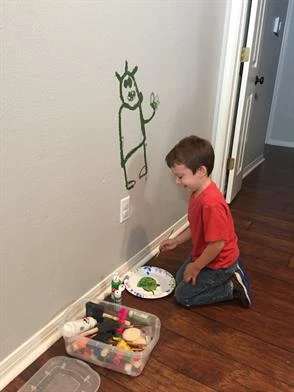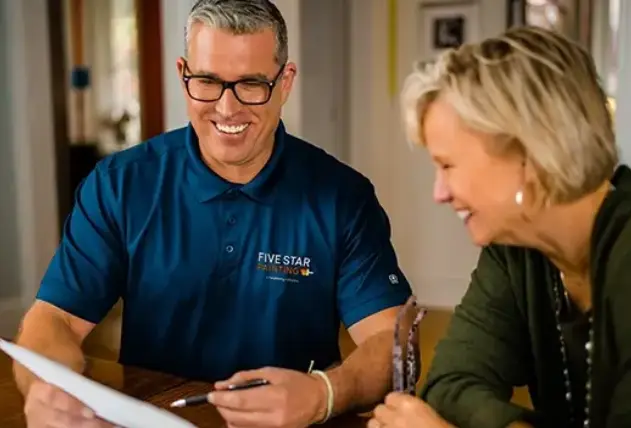
Five Star Painting shares tips for choosing safe craft paints for kids.
|
Five Star Painting knows when it comes to your little ones, you’ll do anything to keep them safe. Painting is a wonderful, creative outlet for children of all ages, but is their paint safe? Give your kids the highest-quality tools to create their masterpieces with this “craft paint guide” from Five Star Painting!
- Tempera Paint:Tempera paint is a great paint choice because it’s easy to clean, dries fast and won’t crack or flake. Tempera comes in matte and glossy finishes, and works well on paper, cardboard, wood or canvas surfaces. Tempera comes in both liquid and powder formulas, but powder should not be mixed around children, as the dust particles are hazardous when inhaled.
- Activity Paint:As the name suggests, this paint is perfect for a wide variety of activities. Created specifically with children in mind, activity paint is a water-based gel paint that washes easily and adheres to a large variety of surfaces.
- Watercolor Paint:Watercolor is bright, transparent and good for subtle transitions of color. It is best used on thick watercolor paper, as it needs a surface with maximum absorption.
- Finger Paint:Especially recommended for the youngest of artists, finger paint washes easily from the skin and is used best on thicker paper products. Choose a creamy formula to prevent splashing.
- Acrylic Paint:Acrylic paints are richly pigmented and mix well. They are the most permanent option and are water-resistant. Acrylic paint is best used on paper, wood, and canvases. Though acrylic paints labeled “non-toxic” are safe, it’s best that young toddlers stick to other craft paints. As toddlers tend to put their fingers in their mouths, choosing one of the previously mentioned paint types would be a safer choice altogether.
 Remember! Regardless of which type of craft paint you choose, look for paints that are non-toxic and have the Art and Creative Materials Institute’s AP (Approved Product) seal.
Remember! Regardless of which type of craft paint you choose, look for paints that are non-toxic and have the Art and Creative Materials Institute’s AP (Approved Product) seal.
This seal indicates that a product aligns with the ACMI’s safety standard for art materials. Products with the AP seal “are certified in a toxicological evaluation by a medical expert to contain no materials in sufficient quantities to be toxic or injurious to humans, including children, or to cause acute or chronic health problems.” (acmiart.org, “Art Material Safety”)
Another indicator of safe craft paint is the “ASTM D-4236” code. Paint that displays this code has been approved by the American Society for Testing and Materials.
Not the Wall!
A young artist should not be limited in their expression by the safety of (or lack thereof) their tools. Otherwise, you may find them being creative in their selection of art surfaces. (See photo!) If you do end up with a new, modern art debut on your wall, check out our blog on Difficult Colors to Paint Over. Ensure your child is safe at their easel by choosing craft paint that fits his/her needs. Contact Five Star Painting If you would like to learn more about interior painting or our other professional services, contact Five Star Painting today!
This article is intended for general informational purposes only and may not be applicable to every situation. You are responsible for determining the proper course of action for your home and property. Five Star Painting is not responsible for any damages that occur as a result of this blog content or your actions. For the most accurate guidance, contact the Five Star Painting location nearest you for a comprehensive, on-site assessment.
FAQs About Safe Craft Paints
Our years of experience, attention to detail, and decades-long commitment to exceptional customer service set Five Star Painting apart from the competition. Continuing this high standard also includes using our knowledge and experience to answer your most frequently asked questions about the paint for crafts made by kids.
What’s the safest paint for toddlers?
Always prioritize paints labeled specifically for toddlers and supervise children during art activities. When selecting paint for toddlers, safety is paramount: Toddlers explore the world through their senses, and that often includes putting things in their mouths. Therefore, it's important to choose paints that are non-toxic and specifically designed for young children.
Key considerations include:
- Non-toxic: Look for paint for crafts that are labeled “non-toxic,” that meet ASTM D-4236 safety standards, and that feature the Art and Creative Materials Institute’s AP (Approved Product) seal.
- Washable: Easy cleanup is essential. Washable paints minimize stains on skin and clothing, allowing you to focus on making easy paintings for children.
- Food-grade or natural ingredients: Paints made with natural ingredients or even food-grade components offer an extra layer of safety.
Here are some examples of toddler and skin-safe paint options:
- Crayola Washable Kids' Paint: A popular and widely available option known for its washability and non-toxic formula.
- Tempera paint: Generally safe and washable, tempera paint is a common choice as a paint for crafts. When purchasing, always check the labels to ensure non-toxicity.
- Eco-Kids Finger Paint: Made with natural ingredients, this option is designed for finger painting and is considered very safe.
- Real Milk Paint: This is made from natural ingredients and is a very safe paint option.
- Kwik Stix Solid Tempera Paint Sticks: These non-toxic paint sticks offer a fun painting experience with less mess.
Can kids use acrylic paint for crafts?
While acrylic paint is popular for crafts, it's generally not recommended for very young children. Here's why:
- Toxicity: Although many acrylic paints are technically “non-toxic” after drying, they can contain chemicals that are harmful if ingested in large quantities, which is a risk with toddlers.
- Permanence: Acrylic paint is difficult to remove from skin and clothing, leading to potential staining.
- Chemical sensitivities: Some children may have sensitivities or allergies to the chemicals in acrylic paints, disqualifying them as skin-safe paints.
- Application: Acrylics dry quickly, which can make them less forgiving for young children still developing fine motor skills.
Crafting with certified non-toxic acrylic paints can be a great activity for older children, provided they remain under careful supervision. Older children can better understand the importance of not ingesting the paint and the need to wash their hands after use. Always ensure proper ventilation when using acrylics.
In summary, acrylics can be good pigments for easy paintings for children. However, only older children should be trusted to use them. Younger children and toddlers should avoid acrylic paint.
How do I remove kids’ paint from clothes?
Dealing with kids' paint-splattered clothing can be frustrating, but many stains can be removed with the right approach. The key is to act quickly before the paint dries and sets.
Here's a step-by-step guide to removing paint for crafts from kids’ clothing:
- Blot, don't rub: If the paint is still wet, gently blot the stain with a clean, dry cloth or paper towel. Rubbing can spread the paint and push it deeper into the fabric.
- Rinse with cold water: Hold the stained area under cold, running water to loosen the paint. Avoid hot water, as it can set the stain.
- Apply dish soap: For washable paints, apply a small amount of mild dish soap directly to the stain. Gently rub the soap into the fabric with your fingers or a soft cloth.
- Wash in cold water: Wash the garment in cold water with your regular laundry detergent. Check the stain before drying. If the stain persists, repeat steps 3 and 4.
- For acrylic paint: Acrylic paint is more difficult to remove, so try rubbing alcohol or nail polish remover (acetone) on the stain. Test a small, inconspicuous area of the fabric first to ensure it won't damage the material. After applying the rubbing alcohol, blot the area, then wash the garment.
- Avoid the dryer: Do not put the garment in the dryer until the stain is completely gone. The heat from the dryer will set the stain, making it nearly impossible to remove.
Remember that these steps may not be universal. The success of stain removal depends on the type of paint and fabric.


